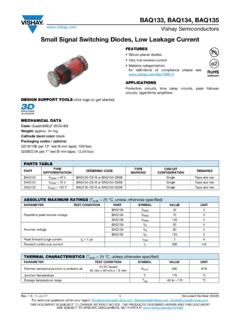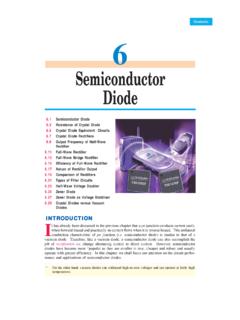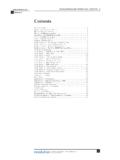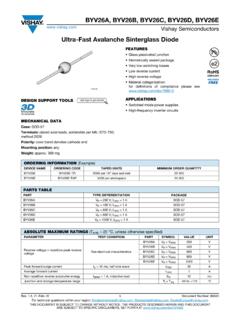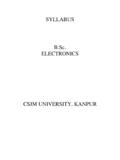Transcription of High Power Laser Diode Driver Based on Power Converter ...
1 46 IEEE TRANSACTIONS ON Power ELECTRONICS, VOL. 12, NO. 1, JANUARY 1997. High Power Laser Diode Driver Based on Power Converter technology Marc T. Thompson, Member, IEEE, and Martin F. Schlecht, Senior Member, IEEE. Abstract This paper describes the design of a high speed The Laser Driver is designed to operate in the Polaroid semiconductor Laser Diode Driver designed for driving 500 mW to Corporation's Helios Medical Laser Imaging System. The W diodes at full optical Power modulation up to frequencies circuits described were built using standard PC board and of 10 MHz. The duty cycle of the modulation may be varied.
2 A. switching Power - Converter Based current source allows a higher surface-mount component technologies. The work is further Power delivery efficiency to the Diode than in previous designs, described in Patent #5 444 728 (8/22/95). allowing for a more modest Power supply and dissipation re- quirements. A dynamic ripple cancellation circuit reduces the II. SYSTEM OVERVIEW. Power Converter output current ripple to less than 1% of full- scale current. The circuit is capable of delivering up to A to a Electrically, a semiconductor Laser behaves as a Diode with a Laser load, with a 10 90% switching risetime from Laser threshold voltage turn-on knee greater than 1 V.
3 When the Laser is biased to full on of less than 20 ns. with a sufficient current so that lasing occurs, a further increase in injected current results in a proportional increase in Laser I. INTRODUCTION optical output. For representative Laser diodes, the frequency response of optical Power output due to a change in Laser A S A RESULT of progress in semiconductor Laser technol- ogy, Laser diodes are now available with continuous-wave (CW) optical output Power greater than 1 W. Due to the current is flat out to a resonance at a very high frequency (on the order of to 2 GHz) [2], [9], [18], [20], [29].
4 This resonance is due to Laser relaxation processes. inherent high speed of the lasing process, direct modulation For the particular application considered in this paper, the of the Laser current is an attractive method of high speed Diode is to be operated at a maximum modulation frequency of modulation of the Laser Power output, and high speed current a few megahertz, with a risetime (depending on Laser current drivers for these devices are needed. This allows high Power set-point) of approximately 10 20 ns. The Laser Diode will lasers diodes to be used in new applications in communications be square-wave modulated at any duty cycle, controlled by a and medical imaging.
5 TTL input signal. This modulation frequency is much lower Previous designs for high-speed modulation of lasers are than the Laser 's resonant frequency, so the resonance is not suitable for driving low Power diodes (less than 50 mW excited significantly. The light output response exhibits little optical Power output) [1], [3], [5] [8], [10] [12], [17], [19], overshoot with a Diode intrinsic risetime on the order of a [21], [24], [26]. These designs are Based on linear amplifier nanosecond. The ultimate limitations in achievable switching techniques. For these lower powered lasers, switching currents speed are due to the parasitic inductances and capacitances of are on the order of 100 mA or less and hence Power handling the Laser package and the risetime of the current Driver .
6 Requirements are minimal. For driving higher-powered lasers, In order to maintain constant optical Power output, it the low efficiency of these topologies become important. Also, is desirable to make the injected Laser current independent more care is needed in the circuit design because of the higher of temperature. Therefore, the Laser is driven with a high current slew rate required. A high speed, lower-loss topology impedance current source. The Laser is also fitted with a is considered in this paper. thermo-electric (TE) cooler so as to maintain constant Laser In this paper, a high speed current Driver for direct mod- chip temperature so that optical Power remains constant at ulation of Laser diodes is described.
7 An adjustable dc current constant current [13]. Optical feedback is carried out by using source is generated from the Power supply voltage using a a photodetector and relatively slow feedback loop to detect switching down- Converter technique. This current is switched and compensate for optical Power output variations as the Laser to and from the Laser under control of an externally applied ages [4], [14], [16], [22], [25]. The details of the TE cooler TTL signal. A second adjustable dc current source pre-biases design and optical feedback are not considered here. the Laser Diode to the lasing threshold.
8 An active ripple The Laser current is modulated between two pre-set values reduction circuit compensates for the ripple current at the and The threshold current bias the Laser to a Converter switching frequency. point where is just begins lasing. is the current necessary Manuscript received June 8, 1995; revised July 8, 1996. This work to generate a given optical output Power . For a 1 Watt was supported by Polaroid Corporation, Medical Imaging Systems Division, semiconductor Laser , representative values for and are Newton, Massachusetts. 300 mA and A, respectively. Due to device manufacturing The authors are with the Laboratory for Electromagnetic and Electronic Systems, Massachusetts Institute of technology , Cambridge, MA USA.
9 Process variations, these values vary considerably from device Publisher Item Identifier S 0885-8993(97)00416-X. to device and change somewhat as the device ages. 0885 8993/97$ 1997 IEEE. THOMPSON AND SCHLECHT: HIGH Power Laser Diode 47. TABLE I. Laser Driver SPECIFICATIONS. Power supplies +12 V; 012 V 6 5%. Threshold current 0 < Ith < 500 mA. Laser peak current 750 mA < Ipk < 2:5 A. 10 90% switching risetime R < 20 ns Converter switching frequency 800 kHz Laser current ripple <20 mA, p-p Laser ON resistance < 0 :5 Laser ON voltage <3 V @ full current Fig. 1. Laser Driver system block diagram.
10 Referring to the block diagram (Fig. 1), the Laser modulation is under control of an input TTL signal. This signal causes rapid switching of the switching array. When the Laser is on, Laser current flows through the Diode . When the Laser is off, only the pre-bias current flows through the Diode , with Fig. 2. Power Converter arranged as a current source. being shunted around the Laser . The average value of total Laser current is sensed. The low. Therefore, every effort is made to reduce the inductance loop filter and pulse-width modulator maintain the necessary of the printed-circuit board routing and of the interconnection average current.


